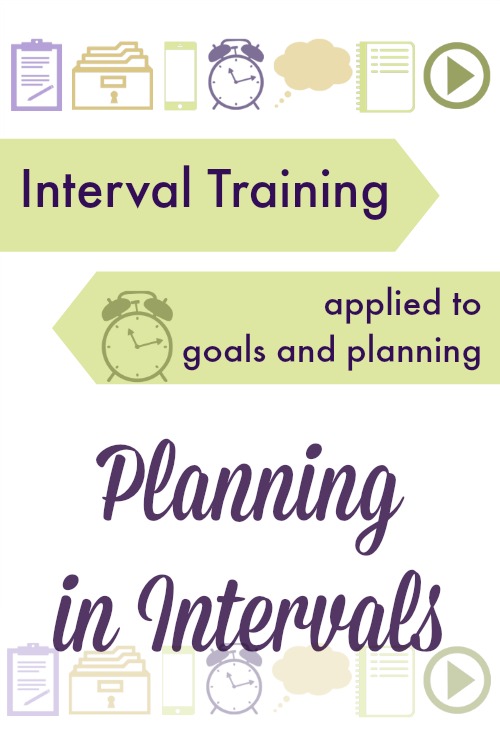Interval Training Strategy: Making an interval plan work for you
Use the theory behind interval training to maximize your planning effectiveness. Just as runners train and gain strength and endurance by running in short, intense bursts and then going at a slower pace for awhile, so we can follow the same pattern in our day-to-day lives.

Breaking up your year into intervals, with rest periods in between, is a great way to keep your head wrapped around what you have to do and also keep up your energy as you do them. Planning for a space of time that is long enough to complete a small project or at least accomplish milestones in a large project helps you retain focus and the benefits of deadlines and end-of-season pushes that usually only happen at the end of school years, fiscal years, or calendar years. You never get to slump into the “I have plenty of time” mentality as is so easy come February for those annual goals.
Listen to this post:

What are the components of planning with interval training?
For my own interval plans, I write out (or type out in Evernote, actually) the dates my interval spans. Then I list 3 projects for that term. That’s not three per role or responsibility, but three total. An event such as a birthday party or church fundraiser is a project. If I try to do more than three projects in the midst of keeping up with everyday life, then my energy and focus will be too diffused and I will be ineffective.
Underneath each project heading, then, I start listing out what needs to happen to complete the project. I try to break it down into small steps so I can get momentum in the day to day and not spin my wheels with vague and nebulous goals. This is interval training because the more we think and act in these manageable periods, the better we get at executing our plans.
In addition to the two or three projects per term, I also allow myself to list up to 5 smaller tasks to accomplish.
One very effective part of my interval plan is to choose one habit to really focus on for the entire six week period. Small daily habits are the real key to change and to momentum in life. We all run on habit whether or not we’ve intentionally chosen those habits; interval planning allows you the space to really work on cultivating the habits you want and replacing the habits you don’t want.
So my interval plan has three parts:
- 2-3 projects
- up to 5 small tasks
- 1-3 habits
How long should an interval be?
You should determine the best way to break up your year. Because we homeschool on a six-week on and one-week off schedule, using that same timetable for planning makes sense for us. Just as this “sabbath model” saves my sanity (and the state of my house) in our homeschool, so it increases my effectiveness and maintains my energy in my other projects and my life as a whole.
If your calendar is broken up into natural chunks already, then that’s the best format to use across your life. In general, breaking it up into 6-12 week segments is the best plan. Six weeks is longer than a month – you can have enough lead time to get a big project or event both begun and finished. A month seems like a natural segment, but it really isn’t long enough to get real traction going. However, if you make your interval longer than 12 weeks, you begin to suffer from the feeling that you have plenty of time and lose the sense of urgency and motivation to push. It’s the difference between running 3 minutes or 20 minutes. You can go all out for three minutes because you can spot the end point and you know you will have a chance to recover. Twenty minutes, however, feels like an eternity and it’s hard to keep up your pace.
How does planning in intervals work?
The steps to setting up, planning, and implementing an interval training plan are simple:
- Decide on the length of your intervals. Make sure you include a rest week between your intervals.
- During the rest week before your interval, list 2-3 projects to complete, up to 5 small tasks to do, and 1 habit you want to solidify.
- During your weekly review or weekly preparation time (more on that in coming weeks), look at your interval and make an action plan for the week on what steps you will take to get you nearer your goals. Write out your habit each day on your daily index card plan.
- After your interval is over, assess your plan and your progress and take a sustained break (more on that later, as well).


